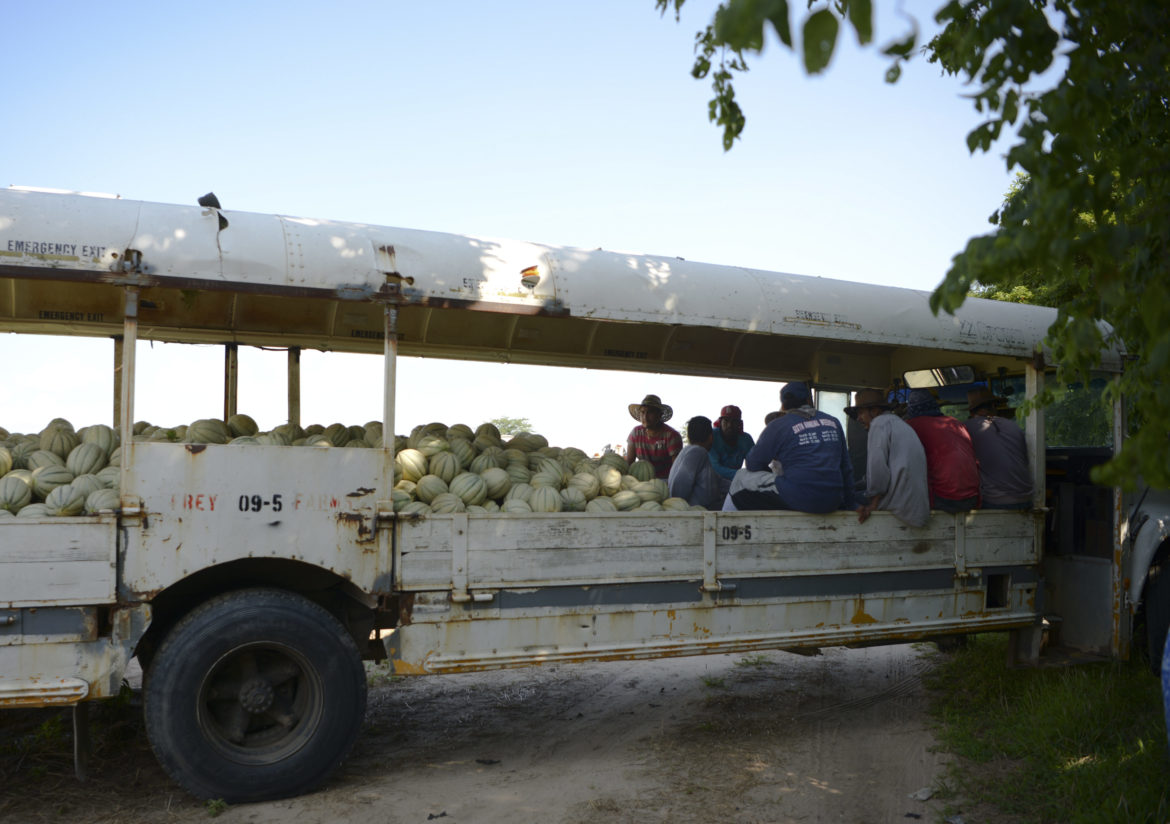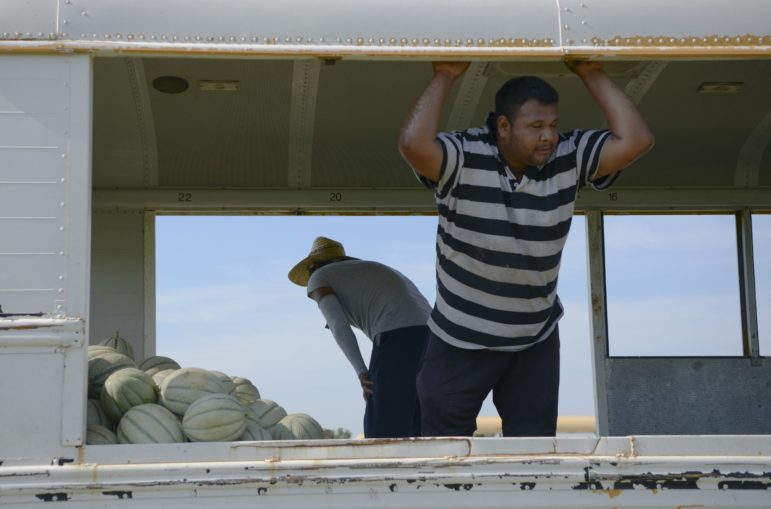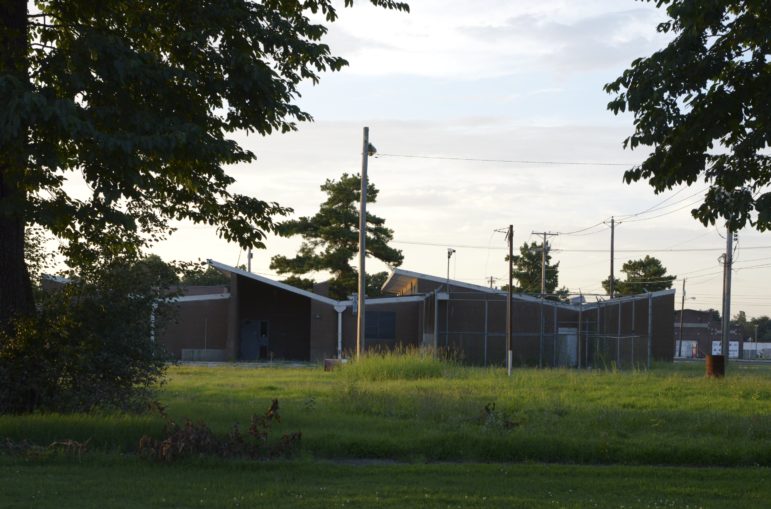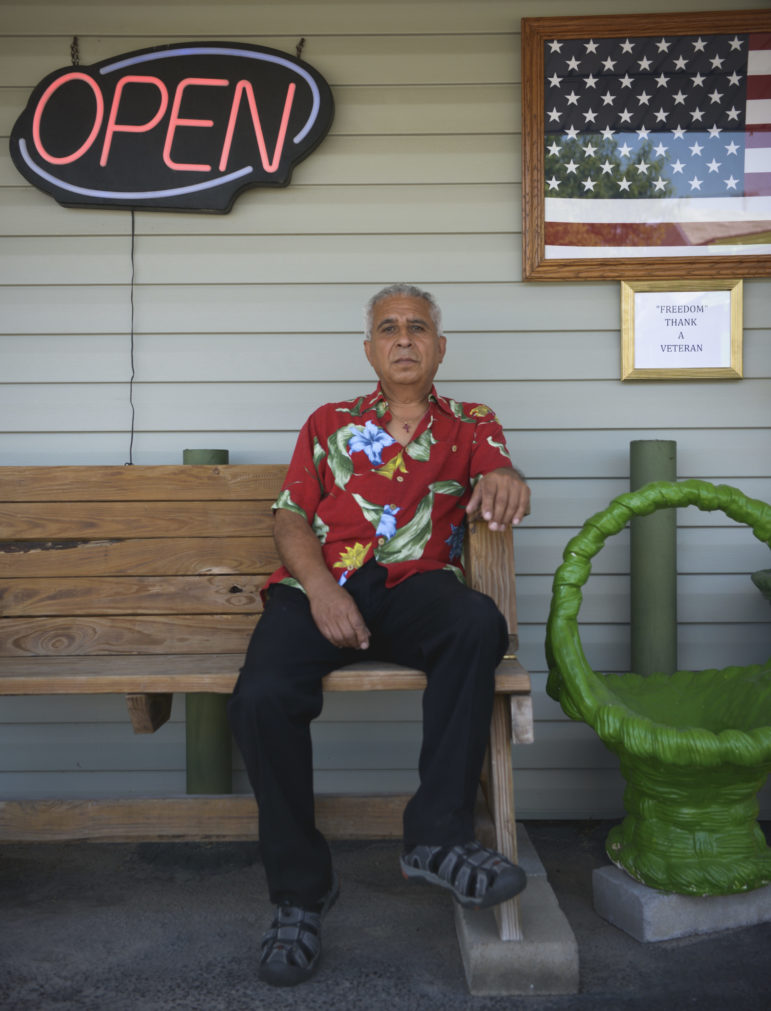
A Crew of migrant farm workers picks cantaloupe on Thursday, July 4, 2019 north of Kennett, Missouri. The crew arrived in Missouri’s Bootheel from Georgia about nine days previously, but had not worked the last six days because the crop was not ripe yet. They were planning to begin picking watermelons Friday morning. The crew will remain in the Bootheel for roughly a month and a half before traveling north to continue harvesting in the midwest. The crew began harvesting the cantaloupe around 9 a.m. on Thursday. They worked for two hours before stopping to get water and take a lunch break. The crews worked with 11 people to a bus. Four people were walking along the rows, picking fruit and passing in down the line toward the bus. Two people were in the bus, receiving the fruit and stacking it, and one person slowly drove the bus down the field and back. The temperature was 86 degrees Fahrenheit at 9:15 a.m. with 75% humidity in Kennett, Missouri, according to the National Weather Service. Julia Hansen/Photographer

Share
The lax inspection process led to an incident in summer 2018 where workers lived in a former jail, a motel with bed bugs and a house with a leaking toilet.
This is part two of a two-part story on migrant workers in Missouri. Read part one: These farmworkers were forced to labor on empty stomachs. This article was originally published in The Midwest Center for Investigative Journalism.
Missouri’s process of inspecting migrant farmworkers’ housing is riddled with holes and easily abused, according to interviews and documents.
Last summer, the process led to an incident where more than a hundred farmworkers, in the U.S. legally on H-2A visas, were forced to live in horrid conditions, to work on empty stomachs and to endure threats.
H-2A workers’ temporary legal status carries the promise of adequate housing, which the federal government leaves up to the states to ensure. But the inspection process, which all states are supposed to follow, doesn’t cover every place H-2A workers live; relies too much on the word of employers, who face little to no punishment for violations; and, in Missouri, has missed deficiencies for years that left workers in unsanitary housing.
The U.S. Department of Labor, which oversees the H-2A program, investigated the incident last summer in Kennett, Missouri, eventually suing the workers’ employer.
Workers were housed in a cramped and dirty motel teeming with bedbugs, then a former county jail with questionable plumbing that used to be a Halloween haunted house. Barbed wire laced the jail’s fence.
Some stayed in two houses with trash piled high inside and out. One had a leaking toilet, and the other’s refrigerator didn’t work. Milk was stored in the freezer.
While motels and rental housing are exempt, states are required to inspect employer-owned housing before H-2A workers arrive.
But the former jail wasn’t inspected. Despite an application to federal authorities to house people there, the workers’ employer told the inspector no one would live there.
The two houses were also approved, though at least one federal violation was missed. Two months later, investigators would find “unsafe, deteriorating and unsanitary” conditions, according to court documents.
The Missouri Department of Economic Development, which oversees the state’s H-2A program, insisted the houses were livable at the time of the inspection. In response to a list of detailed questions, the workers’ employer, Jorge Marin, said his intention was to “comply with all requirements.”
Last year’s lawsuit against Marin was dismissed, and this year he has operations in Florida and Indiana, where he was fined $1,650 for, among other infractions, housing violations in 2015. He has a crew in Missouri this summer, too.
Lax inspections are a result of too little funding, which is a problem across the country, advocates said.
Regulating the H2-A program is largely left to individual states. Each year, more and more people come to America on H-2A visas, but the federal grants that states receive to administer their programs have stagnated. The situation, advocates said, has left states hard-pressed to perform all their duties under the program, of which housing is a small part.
Between 2006 and 2016, the number of H-2A workers who came to the country increased by 180 percent, from about 59,000 to about 166,000, according to U.S. Department of Labor statistics.
During the same time period, the total amount of grant money to states only increased with the rate of inflation, from $12 million to about $14 million, according to federal grant documents.
The number of workers increased to about 240,000 in 2018, the latest year available, but the total amount of grant money has remained steady, at about $14 million for fiscal year 2019.

A Crew of migrant farm workers picks cantaloupe on Thursday, July 4, 2019 north of Kennett, Missouri. The crew arrived in Missouri’s Bootheel from Georgia about nine days previously, but had not worked the last six days because the crop was not ripe yet.
Julia Hansen/Photographer
One state has recognized the problem. Washington recently received $400,000 in federal grants to run its H2-A program, and this year lawmakers considered a bill that would charge farmers a fee for every H-2A worker they hire. The original plan aimed to raise $2 million annually to help the program cover all its responsibilities, including housing inspections. But the fees were ultimately dropped, and lawmakers passed a billcreating a committee to review the situation’s issues.
In recent years, Missouri has received about $150,000 in federal grants. The state puts none of its own money toward the program so the grants cover two state employees’ salaries and all related costs, according to a spokeswoman for the Missouri Department of Economic Development, which oversees the employees.
The employees’ duties include processing employers’ requests for H-2A workers, surveying employers to set the workers’ wages and inspecting housing. Inspections often mean driving for hours – to and from – rural parts of the state.
The result has been inspections that missed federal violations.
The law states each worker must have at least 50 square feet of space if sleeping in a single bed or 40 square feet if sleeping in a bunk bed.
Missouri conducted about 280 inspections between 2015 and 2018. None of the locations were deemed deficient, according to a review of the state inspection documents.
But, between 2015 and 2018, about 23 percent of workers’ housing that Missouri inspected did not meet the sleeping space requirements, based on the dimensions provided in the inspections and the number of people living there at the time, according to an analysis by the Midwest Center for Investigative Reporting.
Missing space requirements is “very worrisome,” said Greg Schell, an attorney in Florida who has represented migrant farmworkers for decades.
“If they’re not catching that,” he said, “it does make you wonder if they’re catching anything else.”
Presented with the findings, state officials said the issue would be addressed.
“Inspectors measured rooms upon first inspection of the residence, and these measurements were used in future inspections of the same properties,” its statement reads. “This practice, which is not excluded by federal law, allowed miscalculations to be carried forward over multiple years. We’re improving our process and addressing this issue with staff to ensure that the square footage of rooms is properly measured and calculated for each residence going forward.”
In April, after the Midwest Center told the state about the deficiencies, Missouri approved Marin’s two houses for workers again, but with the appropriate amount of space.

Julia Hansen/Photographer
The jail
Months before workers arrived, Marin started making plans to use the former jail. In mid-March 2018, he contacted Metz Skelton, an engineer in Kennett for decades, about redesigning it.
Marin finalized the jail’s purchase on April 4, according to county property records.
He soon knew it had problems.
After surveying the jail, Skelton sent Marin a letter dated April 12 saying it would not be ready by late June, the workers’ arrival date.
The jail had “serious issues with the existing plumbing,” Skelton wrote. The kitchens and bathrooms were missing equipment. He couldn’t verify the status of the electricity or the heating and AC units.
“It is our considered opinion that thousands of dollars in renovation costs will be involved and at this time do not anticipate the facility could be ready for any occupancy for several months,” Skelton wrote in the letter, which he shared.
A Facebook photo from 2016 shows the jail in disrepair, with debris on the ground and graffiti on the walls. Skelton visited a few times throughout April, he said, and it was still a “mess.” Debris had been cleared and the bars had been removed, but that was the extent of the renovation.
“The only thing I saw inside was they were painting,” he said. “I didn’t see anything else.”
Photos included in the DOL’s lawsuit show bare rooms with bunk beds. The walls and appliances had splotches of red paint – fake blood – from when a local organization used it as a haunted house.
A worker on the crew who lived there said it was scary and cold. The bathrooms had no lights, and nothing divided the toilets. A photo shows a toilet with no seat. Cold showers were the norm, said the worker, who requested anonymity out of fear of retaliation.
In the kitchen, the sink, stove, oven and refrigerator didn’t work. “When we opened the fridge door,” the investigator’s affidavit reads, “we discovered an old mattress.”
The inspector visited the area on May 22, 2018, to inspect the two houses. During that inspection, Marin said no one would live in the jail, according to the state. The inspector embarked on the five-hour drive back to her office in the state capital without visiting it.
On July 17, the city issued an occupancy permit for the jail, and Marin moved workersfrom the motel into the jail. They’d stay for about three weeks, until a judge ordered them removed.
In its response to questions about the Marin case, the state said it was changing its processes to “ensure additional record keeping in instances where employers indicate they do not plan to use housing listed” on the worker request form.

The Motel
States aren’t required to inspect motels and rental housing, but that carries its own risks.
In 2016, a Florida watermelon harvester paid a Kennett man to find apartments for about two dozen Mexican H2-A workers, according to local court records. The man told the employer he’d found a big enough place, but really it could only accommodate about a dozen people.
The motel where Marin kept workers before moving them into the jail also had space problems.
Workers slept four-to-six people to a room, according to court records. Their luggage made a tight fit even more cramped. Some shared beds, and some slept on the floor and in bathtubs. They rotated who got the mattresses.
“We were stacked on each other,” the worker on Marin’s crew said.
The beds, mattresses and towels weren’t clean, and the housekeeping practices and pest control procedures weren’t in compliance, according to a county health inspection dated Aug. 28, 2018, about six weeks after workers moved out of the motel and into the jail. The inspection doesn’t mention bed bugs, but the worker said the mattresses were infested with them.
After the DOL’s lawsuit, Marin was ordered to put workers in a motel across town called the 84 West Motel. That’s actually where Marin told state regulators his crew would stay originally.
When the large barracks isn’t full of watermelon harvesters in the summer, the owners, Maria and Juan Toscano, rent it to hunters who come to search the Bootheel’s wetlands for ducks. It has tile floors, wood cabinets and comfy couches.
To satisfy regulators, Marin made a $2,000 down payment at the motel, according to the contract. Per the contract’s terms, keeping workers there would have cost him about $140,000. The former jail was listed at $62,500 on Zillow.
The Houses
Inspectors approved Marin’s two houses, with its spacing deficiencies, for three straight years before the incident in summer 2018, according to the inspection documents.
In 2017, a state inspector noted that the water and electricity wasn’t turned on, and one house’s window was broken. Employers have five days after an inspection to address problems, a state spokeswoman said, and they need to send photos showing improvements.
Before his 2018 request for workers was approved, Marin told the state the two houses would meet all requirements.
“I assure that such housing will be in full compliance with the requirements of the applicable housing standards,” a letter he signed reads.
No problems were noted on the inspection document from May 22. The houses were approved for 11 and 16 people, but investigators later said only 10 and 13 people should have been living there.
They also found problems beyond insufficient space.
The homes’ shared yard had overflowing trashcans, and garbage was piled inside as well. The drywall had holes and pipes were exposed, according to the investigators’ affidavit. In one house, water from a leaking toilet pooled underneath the hallway’s laminate floor. In the other house, the refrigerator didn’t work so milk, juice and soda were stored in the freezer.
According to the state, when the houses were inspected, the toilet was not leaking and the refrigerator worked.
“These inspection reports are a snapshot in time, so it is possible that appliances may break or other damage may occur following the inspection,” the statement reads.
About the author
Sky Chadde recently graduated from the Missouri School of Journalism with a graduate degree focusing on investigative reporting. He’s covered Missouri’s legislative sessions for the Columbia Missourian and the St. Louis Post-Dispatch. Before attending grad school, he was a reporter in Texas.

